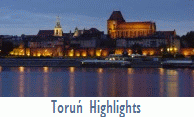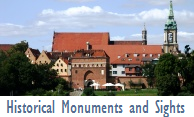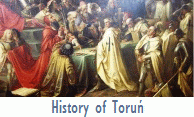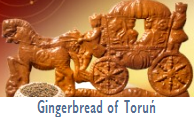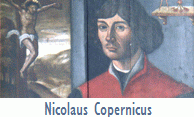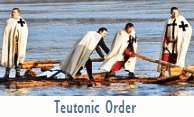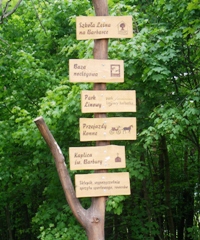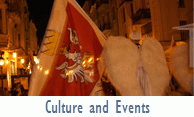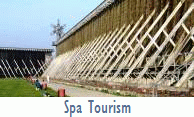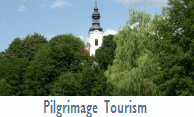|
To be developed soon.
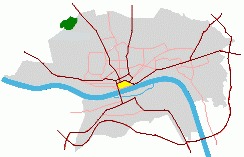 Barbarka is an old woodland settlement on the northern outskirts of Toruń. A recreation site today, it was popularly associated with the cult of St. Barbara in the past. Here, she is believed to have appeared before a hermit beside one of the springs which was famed to have miraculous healing properties. Several times a year Barbarka was visited by pilgrims seeking indulgence granted by Pope Sixtus IV in the mid-15th century. Polish King Sigismund the Elder (Zygmunt Stary) visited the place on 22 April 1521. In the local chapel there was a Gothic figure of St. Barbara of around 1515, which, according to historians, is now a precious art object of historic interest. The surrounding forest was also a place of martyrdom. At the beginning of the World War Two in 1939, the Germans carried out a mass execution here by shooting hundreds inhabitants of Toruń and the area around Toruń, mainly the intelligentsia. Their corpses were dug up and burned by the Nazi in 1944 to cover up war crimes. Barbarka is an old woodland settlement on the northern outskirts of Toruń. A recreation site today, it was popularly associated with the cult of St. Barbara in the past. Here, she is believed to have appeared before a hermit beside one of the springs which was famed to have miraculous healing properties. Several times a year Barbarka was visited by pilgrims seeking indulgence granted by Pope Sixtus IV in the mid-15th century. Polish King Sigismund the Elder (Zygmunt Stary) visited the place on 22 April 1521. In the local chapel there was a Gothic figure of St. Barbara of around 1515, which, according to historians, is now a precious art object of historic interest. The surrounding forest was also a place of martyrdom. At the beginning of the World War Two in 1939, the Germans carried out a mass execution here by shooting hundreds inhabitants of Toruń and the area around Toruń, mainly the intelligentsia. Their corpses were dug up and burned by the Nazi in 1944 to cover up war crimes.
i The first chapel existed here before the year 1299 in the place of the alleged St. Barbara's a revelation before a hermit beside one of the springs (in the early 19th century the spring was called Sacred Spring). In the Middle Ages and in modern times, it was a very popular place of pilgrimage. To this "miraculous" source pilgrims were coming on the day of St. Barbara, on the Whit, the Ascension, to receive the indulgence granted by Pope Sixtus IV in the mid-15th century.
According to local belief the water from the miraculous source was to treat eyes and tangle, which, after immersion of the head in the water had to come off.
At that time, as written communications say, the source was covered with a millstone, and pilgrims were taking water through a hole in the stone. The cult of St. Barbara gradually had been waning since the Swedish invasion in mid 17th century.
In 1340 a water mill was mentioned here (Bormol - mill among the woods). At that time the settlement was ruled by Teutonic commander of Bierzgłowo (Bierzgłowski Castle about 15 km northwest of Toruń and 7 km northwest of Barbarka). The commander Johann Nothaft gave Barbarka to the citizens of Toruń, thus since 1425 the settlement had been a subject to administrative commandery of Toruń. In 1457 Polish King Kazimierz Jagiellończyk (Casimir Jagiellon) granted Toruń the forestry and mill in Barbarka (of total area of 1,056 ha). In 1475, Bishop of Chełmno - Vincent Kiełbasa had built a new chapel in the place of the previous one, which since 1488 had been a subject to St. Johns' church - the parish church of the Old City of Toruń. The chapel had been reconstructed after the Swedish wars around 1660. It was a pretty chopping chapel with 11 windows and small organ. The chapel had survived until 1800, when it was pulled down. A column with the figure of St. Barbara had been built in the place. In 1841 it was decided to build the current chapel. In 1521 Polish King Zygmunt Stary (Sigismund the Elder) paid a visit to Barbarka.
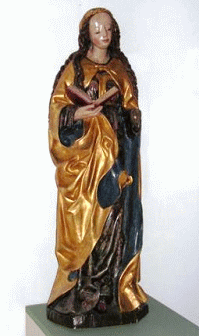 There preserved a Gothic (dated back to 1515) figure of St. Barbara in the chapel. After restoration in the 1960s the figure went to the Diocesan Museum in Pelplin, from where it has returned to Toruń only in 2007 (now it's placed in St. Anthony Church (Polish: Kościół św. Antoniego)). According to art historians it is a valuable monument of great artistic value. There preserved a Gothic (dated back to 1515) figure of St. Barbara in the chapel. After restoration in the 1960s the figure went to the Diocesan Museum in Pelplin, from where it has returned to Toruń only in 2007 (now it's placed in St. Anthony Church (Polish: Kościół św. Antoniego)). According to art historians it is a valuable monument of great artistic value. At the beginning of the 18th century, during the Northern War, the village of Barbarka and the mill buildings were destroyed, however they were restored in a short time. In 1789 the mill was the property of the nobility, and after 1797 it was owned by the city of Toruń again. In the 19th century the mill was converted into a tavern, but even in 1921, Barbarka was mentioned as a settlement of mill. In the interwar period the forest of Barbarka was a city property, although it was not included within the administrative city limits (Barbarka was included in the boundaries of Toruń in 1951). In the years 1927-1935 breeding of pheasants, deer, wild boar, hares, deer and roe deer were carried out by foresters, and pilgrimages have waned. At the beginning of the World War Two in 1939, the Germans carried out a mass execution here by shooting 600 inhabitants of Toruń and the area around Toruń, mainly the intelligentsia, previously incarcerated in the Fort VII. Their corpses were dug up and burned by the Nazi in 1944 to cover up war crimes. The mass grave-monument commemorates this crime and the victims. © Copyright by visittorun.pl >> |
| All rights reserved Toruń 2005-2009 | About us | CenterMedia |




